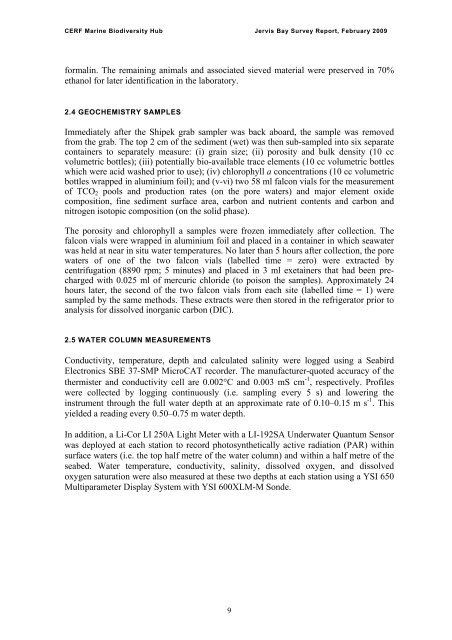Temporal and fine-scale variation in the biogeochemistry of Jervis Bay
Temporal and fine-scale variation in the biogeochemistry of Jervis Bay
Temporal and fine-scale variation in the biogeochemistry of Jervis Bay
- No tags were found...
You also want an ePaper? Increase the reach of your titles
YUMPU automatically turns print PDFs into web optimized ePapers that Google loves.
CERF Mar<strong>in</strong>e Biodiversity Hub <strong>Jervis</strong> <strong>Bay</strong> Survey Report, February 2009formal<strong>in</strong>. The rema<strong>in</strong><strong>in</strong>g animals <strong>and</strong> associated sieved material were preserved <strong>in</strong> 70%ethanol for later identification <strong>in</strong> <strong>the</strong> laboratory.2.4 GEOCHEMISTRY SAMPLESImmediately after <strong>the</strong> Shipek grab sampler was back aboard, <strong>the</strong> sample was removedfrom <strong>the</strong> grab. The top 2 cm <strong>of</strong> <strong>the</strong> sediment (wet) was <strong>the</strong>n sub-sampled <strong>in</strong>to six separateconta<strong>in</strong>ers to separately measure: (i) gra<strong>in</strong> size; (ii) porosity <strong>and</strong> bulk density (10 ccvolumetric bottles); (iii) potentially bio-available trace elements (10 cc volumetric bottleswhich were acid washed prior to use); (iv) chlorophyll a concentrations (10 cc volumetricbottles wrapped <strong>in</strong> alum<strong>in</strong>ium foil); <strong>and</strong> (v-vi) two 58 ml falcon vials for <strong>the</strong> measurement<strong>of</strong> TCO 2 pools <strong>and</strong> production rates (on <strong>the</strong> pore waters) <strong>and</strong> major element oxidecomposition, <strong>f<strong>in</strong>e</strong> sediment surface area, carbon <strong>and</strong> nutrient contents <strong>and</strong> carbon <strong>and</strong>nitrogen isotopic composition (on <strong>the</strong> solid phase).The porosity <strong>and</strong> chlorophyll a samples were frozen immediately after collection. Thefalcon vials were wrapped <strong>in</strong> alum<strong>in</strong>ium foil <strong>and</strong> placed <strong>in</strong> a conta<strong>in</strong>er <strong>in</strong> which seawaterwas held at near <strong>in</strong> situ water temperatures. No later than 5 hours after collection, <strong>the</strong> porewaters <strong>of</strong> one <strong>of</strong> <strong>the</strong> two falcon vials (labelled time = zero) were extracted bycentrifugation (8890 rpm; 5 m<strong>in</strong>utes) <strong>and</strong> placed <strong>in</strong> 3 ml exeta<strong>in</strong>ers that had been prechargedwith 0.025 ml <strong>of</strong> mercuric chloride (to poison <strong>the</strong> samples). Approximately 24hours later, <strong>the</strong> second <strong>of</strong> <strong>the</strong> two falcon vials from each site (labelled time = 1) weresampled by <strong>the</strong> same methods. These extracts were <strong>the</strong>n stored <strong>in</strong> <strong>the</strong> refrigerator prior toanalysis for dissolved <strong>in</strong>organic carbon (DIC).2.5 WATER COLUMN MEASUREMENTSConductivity, temperature, depth <strong>and</strong> calculated sal<strong>in</strong>ity were logged us<strong>in</strong>g a SeabirdElectronics SBE 37-SMP MicroCAT recorder. The manufacturer-quoted accuracy <strong>of</strong> <strong>the</strong><strong>the</strong>rmister <strong>and</strong> conductivity cell are 0.002C <strong>and</strong> 0.003 mS cm -1 , respectively. Pr<strong>of</strong>ileswere collected by logg<strong>in</strong>g cont<strong>in</strong>uously (i.e. sampl<strong>in</strong>g every 5 s) <strong>and</strong> lower<strong>in</strong>g <strong>the</strong><strong>in</strong>strument through <strong>the</strong> full water depth at an approximate rate <strong>of</strong> 0.10–0.15 m s -1 . Thisyielded a read<strong>in</strong>g every 0.50–0.75 m water depth.In addition, a Li-Cor LI 250A Light Meter with a LI-192SA Underwater Quantum Sensorwas deployed at each station to record photosyn<strong>the</strong>tically active radiation (PAR) with<strong>in</strong>surface waters (i.e. <strong>the</strong> top half metre <strong>of</strong> <strong>the</strong> water column) <strong>and</strong> with<strong>in</strong> a half metre <strong>of</strong> <strong>the</strong>seabed. Water temperature, conductivity, sal<strong>in</strong>ity, dissolved oxygen, <strong>and</strong> dissolvedoxygen saturation were also measured at <strong>the</strong>se two depths at each station us<strong>in</strong>g a YSI 650Multiparameter Display System with YSI 600XLM-M Sonde.9

















